
Norges Statsbaner rolling stock
Encyclopedia
Norges Statsbaner operates as of January 1, 2008 36 locomotive
s, 191 multiple unit
s and 206 passenger carriages.
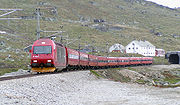
The numbers following the letters are the series. For the El and Di locos, they are numbered chronological from when they were ordered by NSB. For multiple units, electric units are numbered starting with 62 and diesel starting at 83. Following the series number is the road number, unique for each stock. This number has three or four digits.
and painted grey, the Airport Express Train
was painted silver and while the tourist railway Flåmsbana
got green trains.
(*) Does not show locomotive in NSB livery.
Locomotive
A locomotive is a railway vehicle that provides the motive power for a train. The word originates from the Latin loco – "from a place", ablative of locus, "place" + Medieval Latin motivus, "causing motion", and is a shortened form of the term locomotive engine, first used in the early 19th...
s, 191 multiple unit
Multiple unit
The term multiple unit or MU is used to describe a self-propelled carriages capable of coupling with other units of the same or similar type and still being controlled from one driving cab. The term is commonly used to denote passenger trainsets consisting of more than one carriage...
s and 206 passenger carriages.
Locomotives

- 2 Di 2NSB Di 2NSB Di 2 was a diesel-hydraulic locomotive used by the Norwegian State Railways . The 54 delivered locomotives had three axels and were used as shunters throughout the entire NSB system.-History:...
class diesel shunters - 5 Di 4NSB Di 4The NSB Di 4 is a diesel-electric locomotive used by Norwegian NSB railways to haul passenger trains on stretches which are not electrified. They are used mostly on Nordlandsbanen, since the other unelectrified stretches are usually served by diesel multiple units.The five Di 4s which were built...
class diesel locomotiveDiesel locomotiveA diesel locomotive is a type of railroad locomotive in which the prime mover is a diesel engine, a reciprocating engine operating on the Diesel cycle as invented by Dr. Rudolf Diesel...
s, used mostly on the Nordland Line. - 9 El 17NSB El 17The NSB El 17 is a class of twelve electric locomotives built by Thyssen-Henschel and Norsk Elektrisk & Brown Boveri for the Norwegian State Railways . The class was built in two batches, the first delivered in 1982 and numbered 2221–2226, and the second delivered in 1987 and numbered 2227–2232...
class electric locomotiveElectric locomotiveAn electric locomotive is a locomotive powered by electricity from overhead lines, a third rail or an on-board energy storage device...
s, three used for shunting and a further six are run on the Flåm Line. - 22 El 18NSB El 18NSB El 18 is a class of 22 electric locomotives built by Adtranz and Swiss Locomotive and Machine Works for the Norwegian State Railways . The class is a modification of the Swiss Federal Railways Re 460 locomotive and built at Adtranz Strømmen in 1996 and 1997...
class electric locomotives, used on all main electrified lines.
Electric multiple units
- 80 Class 69 class 2-car or 3-car commuter trains, used around OsloOsloOslo is a municipality, as well as the capital and most populous city in Norway. As a municipality , it was established on 1 January 1838. Founded around 1048 by King Harald III of Norway, the city was largely destroyed by fire in 1624. The city was moved under the reign of Denmark–Norway's King...
, BergenBergenBergen is the second largest city in Norway with a population of as of , . Bergen is the administrative centre of Hordaland county. Greater Bergen or Bergen Metropolitan Area as defined by Statistics Norway, has a population of as of , ....
and ArendalArendalis a town and municipality in the county of Aust-Agder, Norway. Arendal belongs to the traditional region of Sørlandet.The town of Arendal is the administrative center the municipality and also of Aust-Agder county...
. - 16 Class 70 class 4-car intercity (medium distance) trains, used around Oslo.
- 36 Class 72NSB Class 72NSB Class 72 is a class of 36 electric multiple units built by AnsaldoBreda for the Norwegian State Railways. Delivered between 2002 and 2005, the four-car units operate on the Oslo Commuter Rail and the Jæren Commuter Rail. The trains have a capacity of 310 passengers and the motors allow a...
class 4-car commuter trains, used around Oslo and Stavanger. - 16 Class 73NSB Class 73NSB Class 73 is a class of 22 electric multiple units built by Adtranz for the Norwegian State Railways. The four-car trains were modifications of Class 71, which was again based on the Swedish X2. The A-series consists of 16 intercity trains; they were delivered in 1999 and 2000 and are used on...
class 4-car long-distance trains, used on Bergen Line, Dovre Line and Sørland Line. - 6 Class 73b class 4-car intercity version of the BM73 used on Østfold Line.
Diesel multiple units
- 14 Class 92 class 2-car trains used for commuter services around TrondheimTrondheimTrondheim , historically, Nidaros and Trondhjem, is a city and municipality in Sør-Trøndelag county, Norway. With a population of 173,486, it is the third most populous municipality and city in the country, although the fourth largest metropolitan area. It is the administrative centre of...
, and on the Røros Line. - 15 Class 93 class 2-car trains used on long distance and intercity services on Rørosbanen, Nordland Line and Rauma Line.
Diesel railcar
- 2 Y1Y1 (railcar)The Y1 is a diesel-hydraulic standard gauge railcar . It is in use in Croatia, Norway, Serbia, Kosovo and Sweden.The production of the railcars was begun in 1980 by Kalmar Verkstad and Fiat Ferroviaria for Sweden.- Italy :...
used on Bratsberg Line between SkienSkien' is a city and municipality in Telemark county, Norway. It is part of the traditional region of Grenland. The administrative centre of the municipality is the city of Skien. Skien is also the administrative centre of Telemark county....
and NotoddenNotoddenis a town and municipality in Telemark county, Norway. It is part of the traditional region of Øst-Telemark. The administrative centre of the municipality is the town of Notodden....
.
Numbering
The fist letter combination of the type defines the category of stock.- El: Electric locomotice
- Di: Diesel locomotive
- Skd: Shunter tractor
- BM: Multiple unit
The numbers following the letters are the series. For the El and Di locos, they are numbered chronological from when they were ordered by NSB. For multiple units, electric units are numbered starting with 62 and diesel starting at 83. Following the series number is the road number, unique for each stock. This number has three or four digits.
Livery
Traditionally NSBs electric and diesel locomotives and carriages were painted green, but in the 1970s this was replaced with red. Shunters were given a yellow color with red cabs. During the late 1990s and 2000s a new color scheme was introduced with multiple colors. Express trains were pained blue and silver, regional trains red and silver while local trains became green and silver. The freight trains were moved to the subsidiary CargoNetCargoNet
CargoNet AS is the primary operator of freight trains on the Norwegian railway system. It was formed as NSB Gods after NSB fissioned into a passenger and a freight company. NSB Gods changed its name to CargoNet at the beginning of 2002. It is owned by NSB and the Swedish freight company Green Cargo...
and painted grey, the Airport Express Train
Flytoget
is a Norwegian high-speed airport rail link connecting Oslo Airport, Gardermoen to Oslo Central Station in nineteen minutes. Run by Flytoget AS , it operates on the high-speed Gardermoen Line using sixteen GMB Class 71 electric trains. Normal service frequency is once every ten minutes, with half...
was painted silver and while the tourist railway Flåmsbana
Flåmsbana
The Flåm Line is a long railway between Myrdal and Flåm in Aurland, Norway. As a branch line of the Bergen Line, it runs through Flåmsdalen and connects the mainline with Sognefjord. The line's elevation difference is . The line has ten stations, twenty tunnels and one bridge. It has a maximum...
got green trains.
Locomotives
| Image | Model | Number | In service | Use | Power | Top speed | Note |
|---|---|---|---|---|---|---|---|
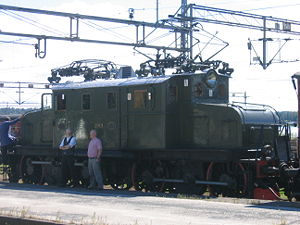 |
El 1 NSB El 1 NSB El 1 is the first electric locomotive series used by Norges Statsbaner, from 1922 until 1973. Twenty-four engines were delivered from ASEA and Thune, twenty-two in 1922 and two in 1930... |
24 | 1922-66 | Universal | 690 kW | 70 km/h | |
 |
El 2 NSB El 2 NSB El 2 was a series of two electric locomotives built by Norsk Elektrisk & Brown Boveri and Thune for Norges Statsbaner in 1923. They remained in service until 1967. Neither has been preserved.-References:*... |
2 | 1923-67 | Universal | 857 kW | 75 km/h | |
| El 3 NSB El 3 NSB El 3 was an electric locomotive used by Norges Statsbaner to transport iron ore on Ofotbanen. Five twin-locomotive sets were in service from 1925 to 1967.-History:... |
10 | 1925-67 | Ofotbanen Ofotbanen The Ofoten Line is a railway line in Narvik, Norway. It runs from the Port of Narvik to Riksgränsen on the Norway–Sweden border, where the line continues as the Ore Line via Kiruna and Gällivare to Luleå. The Ofoten Line is single track, electrified at and has seven stations. The line only... |
60 km/h | |||
 |
El 4 NSB El 4 NSB El 4 was an electric locomotive used by Norges Statsbaner to transport iron ore on Ofotbanen. NSB had a total of five triple-locomotive sets.-History:... |
15 | 1926-65 | Ofotbanen | 2088 kW | 60 km/h | |
 |
El 5 NSB El 5 NSB El 5 was an electric locomotive built by AEG, Norsk Elektrisk & Brown Boveri, Siemens, Hamar Jernstøperi and Thune between 1927 to 1936, with a total of 12 units being delivered to Norges Statsbaner. They were capable of 1,044 kW and top speed of 70 km/h. Number 2039 is preserved by the... |
12 | 1927-72 | Universal | 1044 kW | 70 km/h | |
| El 6 NSB El 6 NSB El 6 was twp electric locomotive delivered in 1912 to Norsk Transport that operated Rjukanbanen and Tinnosbanen, where they were designated RjB.4 and 5... |
1 | 1911-56 | Rjukanbanen Rjukanbanen The Rjukan Line , at first called the Vestfjorddal Line, was a Norwegian railway line running through Vestfjorddalen between Mæl and Rjukan in Telemark. The railway's main purpose was to transport chemicals from Norsk Hydro's plant at Rjukan to the port at Skien, in addition to passenger transport... |
45 km/h | |||
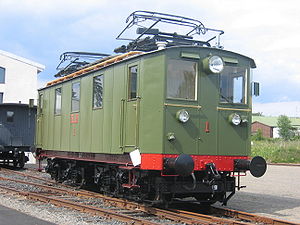 * * |
El 7 NSB El 7 NSB El 7 was a series electric locomotives delivered between 1911 and 1918 to Norsk Transport that operated Rjukanbanen and Tinnosbanen, where they were designated RjB.1, 2, 3, 6, 7 and 8... |
2 | 1911-56 | Rjukanbanen | 45 km/h | ||
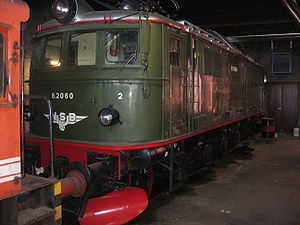 |
El 8 NSB El 8 The NSB El 8 was a Norwegian electric locomotive which was built between 1940 and 1949. Although fast, the El 8 did not have bogies, making it rather stiff in the turns, a problem which was remedied with the introduction of the NSB El 11 and NSB El 13.... |
16 | 1940-87 | Universal | 2080 kW | 110 km/h | |
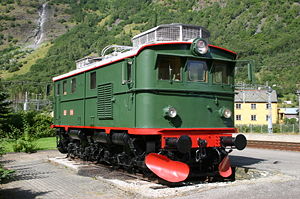 |
El 9 NSB El 9 NSB El 9 is a retired class of three electric locomotives built by Thune for the Norwegian State Railways , with electrical equipment from Norsk Elektrisk & Brown Boveri and Per Kure. The locomotives were delivered in 1947 after a three-year delay caused by wartime sabotage in response to the of... |
3 | 1947-89 | Freight | 712 kW | 60 km/h | |
 * * |
El 10 | 17 | 1931-99 | Shunter | 515 kW | 45 km/h | |
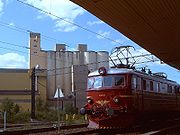 |
El 11 NSB El 11 The NSB El 11 was an electric locomotive which was operated for both passenger and freight trains by NSB. It was the third type of Norwegian electric locomotive with bogies, after the NSB El 7 and NSB El 9. They were manufactured by Norsk Elektrisk & Brown Boveri and Thune mekaniske verksted... |
41 | 1951-98 | Universal | 1676 kW | 105 km/h | |
.jpg) |
El 12 NSB El 12 NSB El 12 was an electric locomotive used by Norges Statsbaner to haul iron ore trains on Ofotbanen between 1957 and 1990. The locomotives were based on the Swedish Dm that was used with success on the connecting Malmbanan. The eight units were always operated in pairs or in triples and were... |
8 | 1954-92 | Ofotbanen | 2398 kW | 75 km/h | |
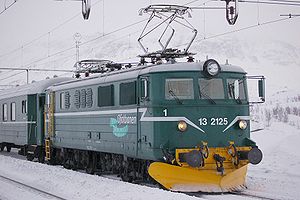 * * |
El 13 NSB El 13 NSB El 13 is a Norwegian electric locomotive which was used by Norges Statsbaner for both passenger and freight trains.The locomotive is a heavier and upgraded version of the NSB El 11 which was popular among its crew but unsuitable for journeys in heavy snow on lines such as Bergensbanen. Like... |
37 | 1957–2003 | Universal | 2648 kW | 100 km/h | |
 * * |
El 14 NSB El 14 NSB El 14 is a Norwegian electric locomotive operated by CargoNet for freight trains hauling. Built between 1968 and 1973 by Thune as a general purpose engine for the Norwegian State Railways , they were seen hauling passenger trains until the 1980s... |
31 | 1968- | Universal | 5082 kW | 120 km/h | Transferfed to CargoNet CargoNet CargoNet AS is the primary operator of freight trains on the Norwegian railway system. It was formed as NSB Gods after NSB fissioned into a passenger and a freight company. NSB Gods changed its name to CargoNet at the beginning of 2002. It is owned by NSB and the Swedish freight company Green Cargo... |
 * * |
El 15 NSB El 15 NSB El 15 is a class of electric locomotives which are now operated by the Swedish company Hector Rail as Class 161 locomotives. The locomotives were originally built for the Norwegian State Railways in 1967 to replace the NSB El 3 and NSB El 4 engines on Ofotbanen... |
6 | 1967-96 | Ofotbanen | 5406 kW | 120 km/h | Transferred to Malmtrafikk, later sold to Hector Rail Hector Rail Hector Rail is a Swedish-based independent train haulage provider operating in the European rail transport market, operating 29 locomotives. The company provides locomotives and drivers to freight customers who need to have whole unit trains hauled between two places with a regular time table.The... |
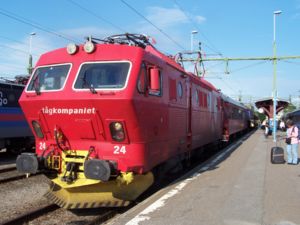 * * |
El 16 NSB El 16 NSB El 16 is an electric locomotive which is used on the Norwegian railway system by CargoNet to haul freight trains. Until it was replaced by the El 18, the El 16 engines also pulled passenger trains.-History:... |
17 | 1977- | Universal | 4440 kW | 140 km/h | Transferred to CargoNet |
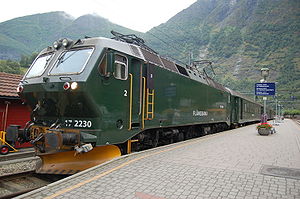 |
El 17 NSB El 17 The NSB El 17 is a class of twelve electric locomotives built by Thyssen-Henschel and Norsk Elektrisk & Brown Boveri for the Norwegian State Railways . The class was built in two batches, the first delivered in 1982 and numbered 2221–2226, and the second delivered in 1987 and numbered 2227–2232... |
12 | 1981- | Passenger | 3000 kW | 150 km/h | Now used on Flåmsbana Flåmsbana The Flåm Line is a long railway between Myrdal and Flåm in Aurland, Norway. As a branch line of the Bergen Line, it runs through Flåmsdalen and connects the mainline with Sognefjord. The line's elevation difference is . The line has ten stations, twenty tunnels and one bridge. It has a maximum... |
 |
El 18 NSB El 18 NSB El 18 is a class of 22 electric locomotives built by Adtranz and Swiss Locomotive and Machine Works for the Norwegian State Railways . The class is a modification of the Swiss Federal Railways Re 460 locomotive and built at Adtranz Strømmen in 1996 and 1997... |
22 | 1996- | Passenger | 5400 kW | 200 km/h | |
| Di 1 NSB Di 1 NSB Di 1 was the first diesel-electric locomotive used by the Norwegian State Railways . The engine was used on the Bergen Line, Dovre Line, Kongsvinger Line and Gjøvik Line... |
1 | 1942-59 | Universal | 1472 kW | 100 km/h | ||
 |
Di 2 NSB Di 2 NSB Di 2 was a diesel-hydraulic locomotive used by the Norwegian State Railways . The 54 delivered locomotives had three axels and were used as shunters throughout the entire NSB system.-History:... |
54 | 1954-73 | Shunter | 441 kW | 80 km/h | |
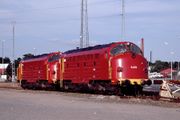 |
Di 3 NSB Di 3 NSB Di 3 is a class of 35 diesel-electric locomotives built by Nydqvist och Holm for the Norwegian State Railways . The class was built between 1954 and 1969, and delivered in two series, Di 3a and Di 3b. They are based on the Electro-Motive Division F7 and are equipped with EMD 567 engines... |
35 | 1957–2000 | Universal | 1305 kW | 143 km/h | |
 |
Di 4 NSB Di 4 The NSB Di 4 is a diesel-electric locomotive used by Norwegian NSB railways to haul passenger trains on stretches which are not electrified. They are used mostly on Nordlandsbanen, since the other unelectrified stretches are usually served by diesel multiple units.The five Di 4s which were built... |
5 | 1980- | Passenger | 2450 kW | 140 km/h | |
 * * |
Di 5 | 17 | 1985-96 | Shunter | 485 kW | 60 km/h | Used DB V260 |
 * * |
Di 6 NSB Di 6 NSB Di 6 is a class of twelve diesel-electric locomotives built by Siemens for the Norwegian State Railways from 1995 to 1996. Twelve engines were built at the MaK plant in Kiel whilst it was part of Siemens Schienenfahrzeugtechnik, and numbered Di 6-661 to 6-672.-Construction:During the late... |
12 | 1996-99 | Universal | 2650 kW | 160 km/h | Returned to builder Some now operated by Cargolink Cargolink Cargolink AS is a Norwegian railway company. Owned by the automotive distribution company Autolink, Cargolink has operated both autorack and container trains since November 2008. Cargolink has a fleet of ten diesel locomotives, five shunters, 100 autoracks and 60 container cars... |
 * * |
Di 7 | 1 | 1993-96 | Shunter | 1235 kW | 100 km/h | Used SJ T44 SJ T44 T44 is a Swedish diesel-electric locomotive built by Nyquist & Holm and Kalmar Verkstad in 123 units between 1968 and 1987. It was the successor of T43, and used both for hauling and shunting. It is the most common diesel locomotive in Sweden, with state-owned Green Cargo as the largest operator... |
 |
Di 8 NSB Di 8 The NSB Di 8 is a class of diesel electric locomotives used by Norwegian railway company CargoNet for freight use.20 engines were built between 1996 and 1997 at the Maschinenbau Kiel plant in Kiel whilst it was part of Siemens Schienenfahrzeugtechnik... |
20 | 1996- | Freight | 1570 kW | 120 km/h | Transferred to CargoNet |
(*) Does not show locomotive in NSB livery.
Multiple units
| Image | Model | Number | In service | Cars | Use | Capacity | Power | Top speed | Note |
|---|---|---|---|---|---|---|---|---|---|
| Class 62 | 4 | 1931-70 | 1 | Branch lines | 73 | 344 kW | 50 km/h | ||
 |
Class 64 | 3 | 1936-85 | 1 | Hardanger Line Flåm Line |
38 | 464 kW | 50 km/h | |
| Class 65 | 49 | 1936-85 | 3 | Commuter rail Branch lines |
464 kW | 70 km/h | |||
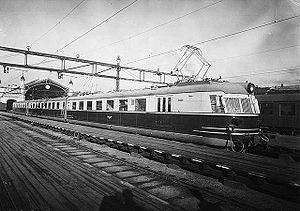 |
Class 66 | 4 | 1945-77 | 3 | Branch lines | 170 | 731 kW | 120 km/h | |
| Class 67 | 18 | 1953-95 | 3 | Commuter rail Branch lines |
468 kW | 70 km/h | |||
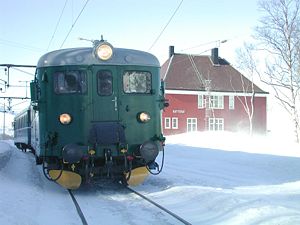 |
Class 68 | 30 | 1956–2001 | 3 | Commuter rail Branch lines |
640 kW | 100 km/h | ||
 |
Class 69 | 85 | 1971- | 2/3 | Commuter rail | 178-306 | 1218 kW | 130 km/h | |
 |
Class 70 | 16 | 1992- | 4 | InterCity Express NSB InterCity Express NSB InterCity Express or ICE is a premium medium distance railway service provided by Norges Statsbaner on the routes Lillehammer–Oslo–Skien and Oslo–Halden–Göteborg with hourly headway... |
230 | 1720 | 160 km/h | |
 |
Class 71 | 16 | 1998- | 3 | Airport Express Train Flytoget is a Norwegian high-speed airport rail link connecting Oslo Airport, Gardermoen to Oslo Central Station in nineteen minutes. Run by Flytoget AS , it operates on the high-speed Gardermoen Line using sixteen GMB Class 71 electric trains. Normal service frequency is once every ten minutes, with half... |
168 | 2646 kW | 210 km/h | Transferred to Flytoget Flytoget is a Norwegian high-speed airport rail link connecting Oslo Airport, Gardermoen to Oslo Central Station in nineteen minutes. Run by Flytoget AS , it operates on the high-speed Gardermoen Line using sixteen GMB Class 71 electric trains. Normal service frequency is once every ten minutes, with half... |
 |
Class 72 NSB Class 72 NSB Class 72 is a class of 36 electric multiple units built by AnsaldoBreda for the Norwegian State Railways. Delivered between 2002 and 2005, the four-car units operate on the Oslo Commuter Rail and the Jæren Commuter Rail. The trains have a capacity of 310 passengers and the motors allow a... |
36 | 2002- | 4 | Commuter rail | 310 | 746 kW | 160 km/h | |
 |
Class 73 NSB Class 73 NSB Class 73 is a class of 22 electric multiple units built by Adtranz for the Norwegian State Railways. The four-car trains were modifications of Class 71, which was again based on the Swedish X2. The A-series consists of 16 intercity trains; they were delivered in 1999 and 2000 and are used on... |
22 | 1997- | 4 | Bergen Line Dovre Line Sørland Line Østfold Line |
204-243 | 3538 kW | 210 km/h | |
| Class 83 | 4 | 1932-63 | 1 | Voss Line Voss Line The Voss Line is a railway line from Bergen to Voss in Hordaland, Norway. The line was opened on 11 July 1883 and became part of the Bergen Line when the latter opened on 27 November 1909, making the Voss Line the first step from Bergen to Oslo. The Voss Line was built in narrow gauge, but... Skreia Line |
224 kW | 75 km/h | |||
| Class 86 NSB Class 86 NSB Class 86 is a class of diesel-hydraulic multiple units built by Strømmens Værksted for the Norwegian State Railways . Thirty-eight motor cars and thirty-one trailers were built between 1937 and 1954, split between six subtypes designated a through f. Class 91 was a further delivery of ten... |
38 | 1938-96 | 2 | Commuter rail Branch lines |
48-70 | 312 kW | 100 km/h | ||
| Class 87 | 25 | 1941-81 | 1 | Branch lines | 59 | 93 kW | 75 km/h | ||
| Class 88 | 6 | 1942-70 | 2/3 | Branch lines | 157 | 970 kW | 120 km/h | ||
 * * |
Class 89 | 5 | 1981-89 | 1 | Flekkefjord Line Flekkefjord Line The Flekkefjord Line is a abandoned branch line to the Sørland Line. It ran between Sira and Flekkefjord in Vest-Agder, Norway. The only current activity on the line is tourist draisines. The station buildings along the line were designed by the architect Paul Armin Due—these have all been... |
47 | 153 kW | 115 km/h | Used SJ Y7 |
| Class 91 | 10 | 1954-86 | 2 | 64 | 312 kW | 100 km/h | |||
 |
Class 92 | 15 | 1984- | 2 | Trøndelag Commuter Rail Røros Line |
90-114 | 714 kW | 140 km/h | |
 |
Class 93 | 15 | 2001- | 2 | Nordland Line Rauma Line Røros Line |
90 | 592 kW | 140 km/h | Bombardier Bombardier Transportation Bombardier Transportation is the rail equipment division of the Canadian firm, Bombardier Inc. Bombardier Transportation is one of the world's largest companies in the rail-equipment manufacturing and servicing industry. Its headquarters are in Berlin, Germany.... Talent Talent (train) The Talent is a multiple unit railcar manufactured by Bombardier that was developed by Waggonfabrik Talbot in Aachen shortly before the company was acquired by Bombardier in 1995... |
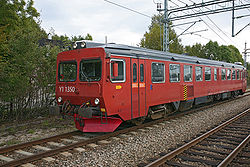 |
Y1 Y1 (railcar) The Y1 is a diesel-hydraulic standard gauge railcar . It is in use in Croatia, Norway, Serbia, Kosovo and Sweden.The production of the railcars was begun in 1980 by Kalmar Verkstad and Fiat Ferroviaria for Sweden.- Italy :... |
2 | 1 | Bratsberg Line | 294 kW | 130 km/h | Used SJ Y1 Y1 (railcar) The Y1 is a diesel-hydraulic standard gauge railcar . It is in use in Croatia, Norway, Serbia, Kosovo and Sweden.The production of the railcars was begun in 1980 by Kalmar Verkstad and Fiat Ferroviaria for Sweden.- Italy :... |

